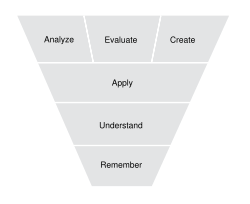Taxonomy of Educational Objectives
From Wikipedia, the free encyclopedia
| This article may require cleanup to meet Wikipedia's quality standards. Please improve this article if you can. (March 2006) |
The Taxonomy of Educational Objectives, often called Bloom's Taxonomy, is a classification of the different objectives and skills that educators set for students (learning objectives). The taxonomy was proposed in 1956 by Benjamin Bloom, an educational psychologist at the University of Chicago. Bloom's Taxonomy divides educational objectives into three "domains:" Affective, Psychomotor, and Cognitive. Like other taxonomies, Bloom's is hierarchical, meaning that learning at the higher levels is dependent on having attained prerequisite knowledge and skills at lower levels (Orlich, et al. 2004). A goal of Bloom's Taxonomy is to motivate educators to focus on all three domains, creating a more holistic form of education.
Most references to the Bloom's Taxonomy only notice the Cognitive domain. There is also a so far less referred, revised version of the Taxonomy, published in 2001 under the name of "A Taxonomy for Learning, Teaching, and assessing", eds. Anderson, Lorin W., Krathwohl, David R., Airasian, Peter W., Cruikshank, Kathleen A., Mayer, Richard E., Pintrich, Paul R., Raths, James and Wittrock, Merlin C.
Contents |
Affective
Skills in the affective domain describe the way people react emotionally and their ability to feel another living thing's pain or joy. Affective objectives typically target the awareness and growth in attitudes, emotion, and feelings.
There are five levels in the affective domain moving through the lowest order processes to the highest:
- Receiving
- The lowest level; the student passively pays attention. Without this level no learning can occur.
- Responding
- The student actively participates in the learning process, not only attends to a stimulus, the student also reacts in some way.
- Valuing
- The student attaches a value to an object, phenomenon, or piece of information.
- Organizing
- The student can put together different values, information, and ideas and accommodate them within his/her own schema; comparing, relating and elaborating on what has been learned.
- Characterizing
- The student has held a particular value or belief that now exerts influence on his/her behaviour so that it becomes a characteristic.
Psychomotor
Skills in the psychomotor domain describe the ability to physically manipulate a tool or instrument like a hand or a hammer. Psychomotor objectives usually focus on change and/or development in behavior and/or skills.
Bloom and his colleagues never created subcategories for skills in the psychomotor domain, but since then other educators have created their own psychomotor taxonomies[1].
Cognitive
Skills in the cognitive domain revolve around knowledge, comprehension, and "thinking through" a particular topic. Traditional education tends to emphasize the skills in this domain, particularly the lower-order objectives.
There are six levels in the taxonomy, moving through the lowest order processes to the highest:
- Knowledge
- Exhibit memory of previously-learned materials by recalling facts, terms, basic concepts and answers
-
- Knowledge of specifics - terminology, specific facts
- Knowledge of ways and means of dealing with specifics - conventions, trends and sequences, classifications and categories, criteria, methodology
- Knowledge of the universals and abstractions in a field - principles and generalizations, theories and structures
Questions like: What is...?
- Comprehension
- Demonstrative understanding of facts and ideas by organizing, comparing, translating, interpreting, giving descriptions, and stating main ideas
-
- Translation
- Interpretation
- Extrapolation
Questions like: How would you compare and contrast...?
- Application
- Using new knowledge. Solve problems to new situations by applying acquired knowledge, facts, techniques and rules in a different way
Questions like: Can you organize _______ to show...?
- Analysis
- Examine and break information into parts by identifying motives or causes. Make inferences and find evidence to support generalizations
-
- Analysis of elements
- Analysis of relationships
- Analysis of organizational principles
Questions like: How would you classify...?
- Synthesis
- Compile information together in a different way by combining elements in a new pattern or proposing alternative solutions
-
- Production of a unique communication
- Production of a plan, or proposed set of operations
- Derivation of a set of abstract relations
Questions like: Can you predict an outcome?
- Evaluation
- Present and defend opinions by making judgments about information, validity of ideas or quality of work based on a set of criteria
-
- Judgments in terms of internal evidence
- Judgments in terms of external criteria
Questions like: Do you agree with.....?
Some critique on Bloom's Taxonomy('s cognitive domain) admit the existence of these six categories, but question the existence of a sequential, hierarchical link (Paul, R. (1993). Critical thinking: What every person needs to survive in a rapidly changing world (3rd ed.). Rohnert Park, California: Sonoma State University Press.). Also the revised edition of Bloom's taxonomy has moved Synthesis in higher order than Evaluation. Some consider the three lowest levels as hierarchically ordered, but the three higher levels as parallel. Others say that it is sometimes better to move to Application before introducing Concepts. This thinking would seem to relate to the method of Problem Based Learning.
See also
- Educational psychology
- Educational technology
- Higher order thinking skills
- Mastery learning
- Physical education
- David Krathwohl
References
- Taxonomy of Educational Objectives: The Classification of Educational Goals; pp. 201-207; B. S. Bloom (Ed.) Susan Fauer Company, Inc. 1956.
- A Taxonomy for Learning, Teaching, and Assessing — A Revision of Bloom's Taxonomy of Educational Objectives; Lorin W. Anderson, David R. Krathwohl, Peter W. Airasian, Kathleen A. Cruikshank, Richard E. Mayer, Paul R. Pintrich, James Raths and Merlin C. Wittrock (Eds.) Addison Wesley Longman, Inc. 2001

